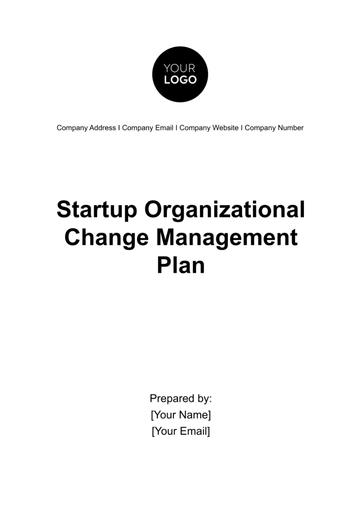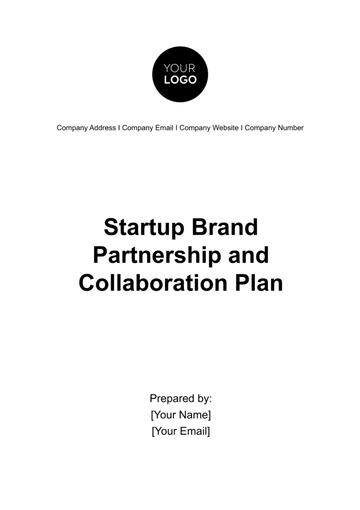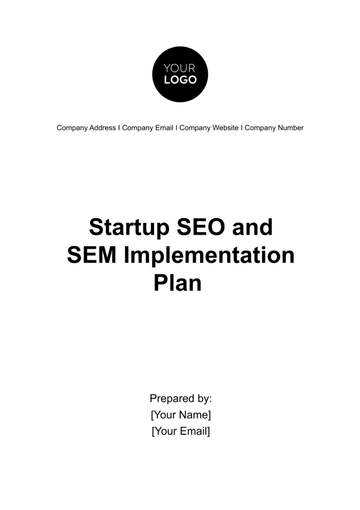Free Startup Financial Plan

Executive Summary
Our startup, [Your Company Name], aims to revolutionize the education technology sector by providing innovative online learning platforms tailored to the needs of students and educators. With a focus on personalized learning experiences and cutting-edge technology, we seek to disrupt traditional education models and empower learners worldwide.
In this financial plan, we outline our projections and strategies for achieving sustainable growth and profitability. Key highlights include:
Revenue projections exceeding $[0] million by Year 3.
Break-even point reached by the end of Year 2.
Capital requirements of $[0] million for startup costs and initial operations.
Business Description
[Your Company Name] is a software-as-a-service (SaaS) company offering a suite of online learning tools designed to enhance engagement, collaboration, and outcomes in education. Our platform leverages artificial intelligence and machine learning algorithms to deliver personalized learning experiences, adaptive assessments, and actionable insights for students and educators.
Target Market: Our primary target market includes K-12 schools, higher education institutions, and corporate training programs seeking to adopt technology-driven solutions to improve learning outcomes and efficiency.
Competitive Advantage: [Your Company Name] differentiates itself through its user-centric design, customizable features, and seamless integration with existing learning management systems. Our team comprises industry experts with extensive experience in education technology and software development, positioning us as a leader in the rapidly evolving tech landscape.
Revenue Projections
Forecast your startup's financial future with confidence using our Revenue Projections section. Tailored by industry experts, this segment offers detailed insights into expected income streams, empowering strategic decision-making and growth planning.
Year | Projections | Amount/Cost |
|---|---|---|
Year 1 |
|
|
Year 2 |
|
|
Year 3 |
|
|
In summary, our Revenue Projections offer a roadmap to financial success, guiding strategic decision-making and growth planning. With detailed insights into income streams, we pave the way for sustainable revenue generation and business expansion.
Expense Projections:
Navigate financial terrain with precision through our Expense Projections section. Designed to anticipate and manage costs effectively, this segment provides a comprehensive breakdown of startup expenses, ensuring fiscal prudence and operational efficiency.
Expenses | Projection | Amount/Cost |
|---|---|---|
Startup Costs |
|
|
Operating Expenses (Monthly) |
|
|
In conclusion, our Expense Projections ensure prudent financial management, offering a comprehensive overview of startup costs. By anticipating and managing expenses effectively, we foster operational efficiency and fiscal responsibility for long-term success.
Cash Flow Statement:
Optimize your startup's financial health with our Cash Flow Statement section. Offering a clear overview of cash inflows and outflows, this segment facilitates prudent cash management, enabling informed decisions and sustainable growth.
Year | Cash Flow | Amount/Cost |
|---|---|---|
Year 1 |
|
|
Year 2 |
|
|
Year 3 |
|
|
To summarize, our Cash Flow Statement provides clarity on cash inflows and outflows, enabling prudent cash management. With insights into liquidity and solvency, we empower informed decisions and sustainable growth for your startup.
Profit and Loss Statement (P&L):
Unlock insights into your startup's financial performance with our Profit and Loss Statement (P&L) section. Featuring detailed analysis of revenues, expenses, and profitability, this segment empowers informed decision-making and strategic planning for success.
Year | Profit and Loss | Amount/Cost |
|---|---|---|
Year 1 |
|
|
Year 2 |
|
|
Year 3 |
|
|
In closing, our Profit and Loss Statement (P&L) offers valuable insights into financial performance. With detailed analysis of revenues, expenses, and profitability, we facilitate strategic planning and informed decision-making to drive success for your startup.
Break-Even Analysis:
Our Break-Even Analysis indicates that [Your Company Name] will reach profitability by the end of Year 2. At this point, our monthly revenue will cover all operational expenses, resulting in a net neutral cash flow. Specifically, we anticipate reaching a monthly break-even revenue of $[0], requiring us to acquire approximately [0] customers by that time. This analysis provides valuable insight into our financial sustainability and serves as a milestone for tracking our progress towards profitability. We will closely monitor our customer acquisition efforts and adjust our strategies as needed to achieve our break-even target.
Capital Requirements:
To successfully launch and scale our operations, [Your Company Name] requires a total funding of $[0] million. This capital will be allocated across various critical areas, including product development, marketing and branding, legal and compliance, initial operating expenses, and contingency reserves. Securing adequate funding is essential for covering startup costs, sustaining operations during the initial phase, and positioning the company for growth. We will seek investment from strategic partners, venture capitalists, and other sources to meet our capital requirements and fuel our expansion plans.
Financial Assumptions:
[Your Company Name]' financial projections are based on several key assumptions that underpin our revenue forecasts, expense estimates, and growth trajectory. These assumptions include a conservative customer acquisition rate of [0]% per month, a monthly churn rate of [0]%, and an aggressive annual revenue growth rate of [0%. Additionally, we assume steady market demand for our innovative learning solutions and a favorable competitive landscape. Continuous monitoring and adjustment of these assumptions will be crucial for maintaining the accuracy and reliability of our financial projections as we navigate the dynamic tech market.
- 100% Customizable, free editor
- Access 1 Million+ Templates, photo’s & graphics
- Download or share as a template
- Click and replace photos, graphics, text, backgrounds
- Resize, crop, AI write & more
- Access advanced editor
Crafted by Template.net, our Startup Financial Plan Template empowers entrepreneurs with an editable and customizable solution for crafting comprehensive financial strategies. Seamlessly integrate your vision with our intuitive AI Editor Tool, ensuring precision and efficiency. Elevate your startup's trajectory with this dynamic template, guiding you towards financial success in the ever-evolving landscape of entrepreneurship.
You may also like
- Finance Plan
- Construction Plan
- Sales Plan
- Development Plan
- Career Plan
- Budget Plan
- HR Plan
- Education Plan
- Transition Plan
- Work Plan
- Training Plan
- Communication Plan
- Operation Plan
- Health And Safety Plan
- Strategy Plan
- Professional Development Plan
- Advertising Plan
- Risk Management Plan
- Restaurant Plan
- School Plan
- Nursing Home Patient Care Plan
- Nursing Care Plan
- Plan Event
- Startup Plan
- Social Media Plan
- Staffing Plan
- Annual Plan
- Content Plan
- Payment Plan
- Implementation Plan
- Hotel Plan
- Workout Plan
- Accounting Plan
- Campaign Plan
- Essay Plan
- 30 60 90 Day Plan
- Research Plan
- Recruitment Plan
- 90 Day Plan
- Quarterly Plan
- Emergency Plan
- 5 Year Plan
- Gym Plan
- Personal Plan
- IT and Software Plan
- Treatment Plan
- Real Estate Plan
- Law Firm Plan
- Healthcare Plan
- Improvement Plan
- Media Plan
- 5 Year Business Plan
- Learning Plan
- Marketing Campaign Plan
- Travel Agency Plan
- Cleaning Services Plan
- Interior Design Plan
- Performance Plan
- PR Plan
- Birth Plan
- Life Plan
- SEO Plan
- Disaster Recovery Plan
- Continuity Plan
- Launch Plan
- Legal Plan
- Behavior Plan
- Performance Improvement Plan
- Salon Plan
- Security Plan
- Security Management Plan
- Employee Development Plan
- Quality Plan
- Service Improvement Plan
- Growth Plan
- Incident Response Plan
- Basketball Plan
- Emergency Action Plan
- Product Launch Plan
- Spa Plan
- Employee Training Plan
- Data Analysis Plan
- Employee Action Plan
- Territory Plan
- Audit Plan
- Classroom Plan
- Activity Plan
- Parenting Plan
- Care Plan
- Project Execution Plan
- Exercise Plan
- Internship Plan
- Software Development Plan
- Continuous Improvement Plan
- Leave Plan
- 90 Day Sales Plan
- Advertising Agency Plan
- Employee Transition Plan
- Smart Action Plan
- Workplace Safety Plan
- Behavior Change Plan
- Contingency Plan
- Continuity of Operations Plan
- Health Plan
- Quality Control Plan
- Self Plan
- Sports Development Plan
- Change Management Plan
- Ecommerce Plan
- Personal Financial Plan
- Process Improvement Plan
- 30-60-90 Day Sales Plan
- Crisis Management Plan
- Engagement Plan
- Execution Plan
- Pandemic Plan
- Quality Assurance Plan
- Service Continuity Plan
- Agile Project Plan
- Fundraising Plan
- Job Transition Plan
- Asset Maintenance Plan
- Maintenance Plan
- Software Test Plan
- Staff Training and Development Plan
- 3 Year Plan
- Brand Activation Plan
- Release Plan
- Resource Plan
- Risk Mitigation Plan
- Teacher Plan
- 30 60 90 Day Plan for New Manager
- Food Safety Plan
- Food Truck Plan
- Hiring Plan
- Quality Management Plan
- Wellness Plan
- Behavior Intervention Plan
- Bonus Plan
- Investment Plan
- Maternity Leave Plan
- Pandemic Response Plan
- Succession Planning
- Coaching Plan
- Configuration Management Plan
- Remote Work Plan
- Self Care Plan
- Teaching Plan
- 100-Day Plan
- HACCP Plan
- Student Plan
- Sustainability Plan
- 30 60 90 Day Plan for Interview
- Access Plan
- Site Specific Safety Plan


























